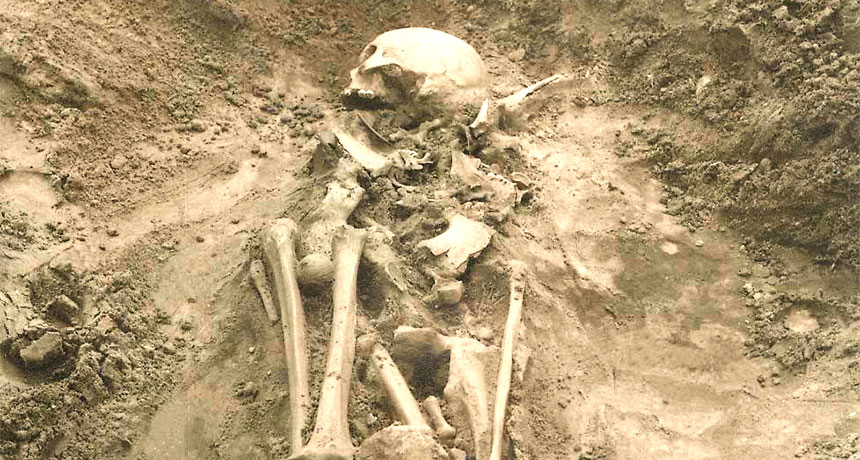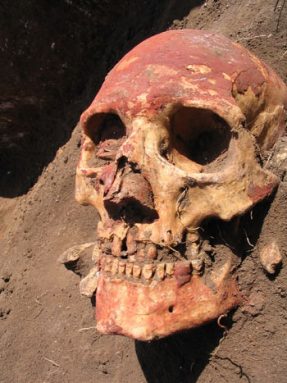The earliest evidence of plague
It struck people living in the Bronze Age, nearly 5,000 years ago

DNA from teeth in seven human skeletons, including this nearly 4,500-year-old find, shows that plague struck Bronze Age peoples in Europe and Asia.
Harri Moora
Share this:
- Share via email (Opens in new window) Email
- Click to share on Facebook (Opens in new window) Facebook
- Click to share on X (Opens in new window) X
- Click to share on Pinterest (Opens in new window) Pinterest
- Click to share on Reddit (Opens in new window) Reddit
- Share to Google Classroom (Opens in new window) Google Classroom
- Click to print (Opens in new window) Print
By Bruce Bower
Starting around 1,500 years ago, bouts of plague swept through Europe and Asia, killing millions of people. But previously unknown variants of the plague germ had begun infecting people in both places much, much earlier. That’s the conclusion of a new study.
Eske Willerslev works at the University of Copenhagen, in Denmark. As an evolutionary geneticist, he studies how the genes in DNA change over very long periods of time. He and his colleagues now report finding DNA from the bacteria that cause plague (PLAYG) in teeth from people who lived during the Bronze Age and early Iron Age. That was between 4,800 and 3,000 years ago!
The plague germ is called Yersinia pestis. Initially, this bacterium would have spread from person to person. This might have happened when a sick person coughed, for instance. If the germ triggered a lung infection, the disease would be called pneumonic (Nu-MON-ik) plague. But if the blood became infected, the symptoms would change and the illness would be called septicemic (Sep-tih-SEEM-ik) plague.
“It’s surprising that the plague was widespread 3,000 years before written records of plagues and well before large-scale urbanization,” Willerslev says. Evidence suggests that Bronze Age herders migrated across Europe and Asia. Those travelers “likely caused the spread of early Y. pestis strains,” he now suspects.
Willerslev’s group described its findings October 22 in Cell.
The new data suggest that different forms of the plague germ “survived in Eurasia for a lot longer than previously expected,” says Hendrik Poinar. An evolutionary geneticist, he works at McMaster University in Hamilton, Canada. Early forms of the germ, however, likely did not set off major epidemics, he notes.
But it certainly did in later times. There was one epidemic in the sixth century A.D. This was during Europe’s Byzantine Empire. But best known is the infamous Black Plague. It wiped out up to half of everyone living in Europe during the mid-1300s. Some 500 years later, a worldwide plague pandemic appeared to get its start in China.
Such mass deaths traced to a form of the disease where a victim’s lymph nodes become infected. Called bubonic plague, this form of the disease likely became possible only sometime within the past 3,700 years, Willerslev’s group now proposes. At that time, a single genetic change, or mutation, suddenly allowed the germ to infect lymph nodes and blood. Once that happened, all it would take for the disease to spread was the bite of an infected flea.
Teeth allow a look back in time
Researchers have been unable to extract the DNA of plague germs from bones that are more than 1,500 years old. But plague DNA has just been retrieved from teeth far more ancient than that.

The researchers looked at the entire genome — all genes — in the Bronze Age DNA samples. This analysis showed that the early germ lacked an important gene. That gene, which was present in the Iron Age individual, would allow the bacterium to survive inside a flea’s gut. So the plague germ’s ability to spread via flea bites evolved at some point between 3,700 and 3,000 years ago, the researchers now conclude.
The biologists also compared the DNA of modern plague bacteria to that in the ancient teeth. From this information, Willerslev’s group now calculates that the most recent common ancestor of all known strains of Y. pestis existed no earlier than 7,022 years ago, and possibly no later than 5,021 years ago. The previous best estimate for that common ancestor had ranged from 1,505 to 6,409 years ago.
Early strains of the plague germ appear to have evolved and died out too quickly to calculate the age of an ancestral strain with any precision, Poinar says.
Plague DNA in one of the oldest Bronze Age individuals and in the most recent Bronze Age person showed another distinctive feature. Both samples lacked a form of one plague gene that keeps an infected person’s immune system from attacking the disease. That suggests that those earlier forms of the plague germ should have been vulnerable to attacks by the immune system.
The researchers now suspect that the ability to evade the immune system evolved at different times in Bronze Age plague germs.
Power Words
(for more about Power Words, click here)
bacterium (plural bacteria) A single-celled organism. These dwell nearly everywhere on Earth, from the bottom of the sea to inside animals.
Bronze Age An archeological period that followed the Old and New Stone Ages. It was the first period in which ancient peoples started using metal. When this occurred varied around the world. In China and Greece, it happened at least 5,000 years ago. In Britain it occurred closer to 3,900 years ago. In the early stages, ancient peoples formed copper into useful tools. True bronze, a metal alloy formed from a mix of copper and tin, came later. Tin deposits in southern England led this region to become a major center of Bronze Age culture.
bubonic plague A disease caused by the bacterium Yersinia pestis. It’s transmitted by the bite of a flea that had previously bitten some rodent infected with the germ. This form of plague causes fever, vomiting and diarrhea. It also inflames the lymph nodes, causing them to swell. Those swollen tissues, called buboes, give this form of the disease its name. Known as the Black Death, bubonic plague killed millions of people in Europe during a series of outbreaks during the Middle Ages.
DNA (short for deoxyribonucleic acid) A long, double-stranded and spiral-shaped molecule inside most living cells that carries genetic instructions. In all living things, from plants and animals to microbes, these instructions tell cells which molecules to make.
epidemic A widespread outbreak of an infectious disease that sickens many people (or other organisms) in a community at the same time.
evolutionary genetics A field of biology that focuses on how genes — and the traits they lead to — change over long periods of time (potentially over millennia or more). People who work in this field are known as evolutionary geneticists.
extract To separate one chemical (or component of something) from a complex mix. Or, a substance, often in concentrated form, that has been removed from its natural source. Extracts are often taken from plants (such as spearmint or lavender), flowers and buds (such as roses and cloves), fruit (such as lemons and oranges) or seeds and nuts (such as almonds and pistachios). Such extracts, sometimes used in cooking, often have very strong scents or flavors.
gene (adj. genetic) A segment of DNA that codes, or holds instructions, for producing a protein. Offspring inherit genes from their parents. Genes influence how an organism looks and behaves.
germ Any one-celled microorganism, such as a bacterium, fungal species or virus particle. Some germs cause disease. Others can promote the health of higher-order organisms, including birds and mammals. The health effects of most germs, however, remain unknown.
immune system The collection of cells and their responses that help the body fight off infections and deal with foreign substances that may provoke allergies.
infection A disease that can spread from one organism to another.
Iron Age A term for ancient human societies that made great use of iron throughout their culture. This period followed directly after the Bronze Age, and is typically described as starting around the 12th century B.C. in Greece, India, Iran, and the Middle East. It started later in other parts of Europe and what is now Turkey. This period continued on throughout all of these regions for many, many hundreds of years.
lymph nodes (or lymph glands) Small nodules located in the armpits, groin and stomach, these organs are part of the lymph system. They secrete lymph and also serve as a storage place for some cells in the immune system.
microbe Short formicroorganism. A living thing that is too small to see with the unaided eye, including bacteria, some fungi and many other organisms such as amoebas. Most consist of a single cell.
mutation Some change that occurs to a gene in an organism’s DNA. Some mutations occur naturally. Others can be triggered by outside factors, such as pollution, radiation, medicines or something in the diet. A gene with this change is referred to as a mutant.
pandemic An epidemic that affects a large proportion of the population across a country or the world.
plague A term for any horrific infection that spreads easily and kills many people, usually quickly. Best known are the infections caused by the bacteriumYersinia pestis. Indeed, they are commonly referred to simply as the plague. In one form, people pick up the germ from the bite of infected fleas. This inflames the lymph nodes, causing them to swell. Those swollen tissues, called buboes, give this form of the disease its name: bubonic plague. When the disease is instead transmitted by inhaling the bacteria, people develop what’s known as pneumonic plague. This form of the disease can be spread when sick people cough. Pneumonic plague is the most deadly form, often killing its victims within 24 hours.
sepsis (also called septicemia) Complications of an infection that can prove life-threatening. It occurs when an inflammatory reaction gets out of control and risks affecting the entire body. Immune chemicals released into the bloodstream start damaging tissues throughout the body. Tissues affected by this runaway inflammation are called septic.
strain (in biology) Organisms that belong to the same species that share some small but definable characteristics. For example, biologists breed certain strains of mice that may have a particular susceptibility to disease. Certain bacteria or viruses may develop one or more mutations that turn them into a strain that is immune to the ordinarily lethal effect of one or more drugs.
urban Of or related to cities, especially densely populated ones or regions where lots of traffic and industrial activity occurs. The development or buildup of urban areas is a phenomenon known as urbanization.
variant A version of something that may come in different forms. (in biology) Members of a species that possess some feature (size, coloration or lifespan, for example) that make them distinct. (in genetics) A gene having a slight mutation that may have left its host species somewhat better adapted for its environment.







